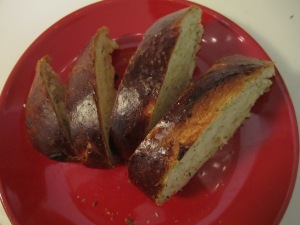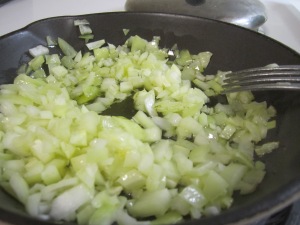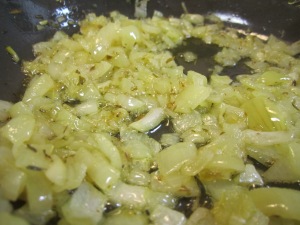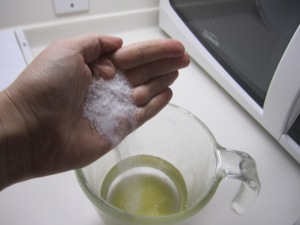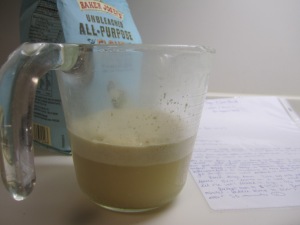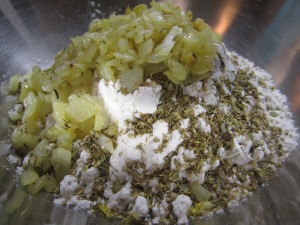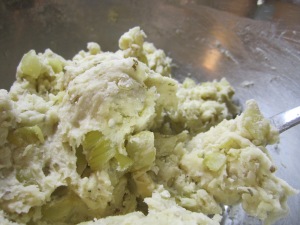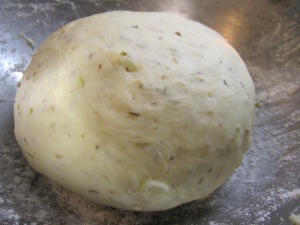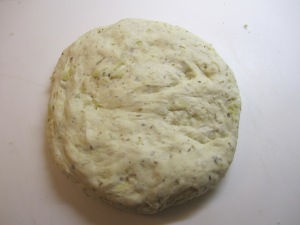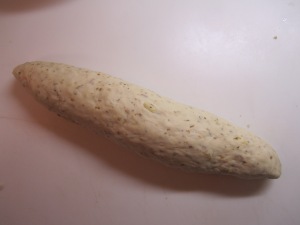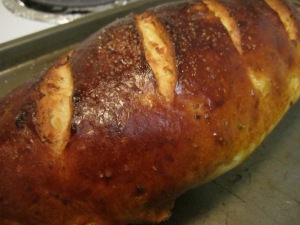While at school, I think I earned the reputation of being the breadmaker. For various events, I was always bringing (or offering to bring) homemade bread, simply because it’s something that 1) I miss a lot when at school and 2) I truly enjoy making. Yes, it takes a long time. I am aware of no-knead recipes and shortcuts, but I think the best part about bread is the process itself: MANUAL LABOR. ELBOW GREASE. Those are just whiny words for KINESTHETIC THERAPY. (See, when I put it like that, the ordeal adopts a medical sound. I could probably open a bakery an employ anyone who needs to vent frustrations and just have them knead my bread all.day.long. Brilliant business model, no ?)
In any case, while home for winter break, I noted this recipe for Onion Oregano bread (from Bon Appétit, 2005) thinking it sounded tasty and would use two ingredients rarely lacking in my pantry: oregano and onions. The original calls for fresh oregano but I used dried to great effect. However, as summer is upon us, those with access to an herb garden should go pick a nice handful of oregano to use with this recipe – the flavor will be fresher, more intense, and a nice compliment to a grilled meal.
I left mine in a hot oven for a smidge too long, as the color is very dark. Ideally, you want to lower the temperature of the oven just as the outside begins to brown so that you don’t have a charred crust and a doughy interior. Lucky for me, the inside was perfectly cooked – just the outside was a little too dark for my liking.
Ingredients :
2 tbsp olive oil
1/2 cup chopped onion
1 1/2 cups warm water (105-115F)
1 envelope active dry yeast (2 1/4 tsp)
1 tsp sugar or honey
4 1/2 cups flour
2 1/2 tsp sa;t
1/4 cup chopped, fresh oregano
1 egg, beaten with 1 tbsp H2O
Directions :
Heat the olive oil in a heavy, small skillet over medium heat. Add the chopped onion, sautéing until translucent. This will only take about 5 minutes, but you are welcome to cook them longer. I love caramelized onions, and I think this bread would be great if it called for an entire cup of onion, caramelized. Season lightly with salt and pepper. Remove from heat and let cool.
In another bowl, pour 1 1/2 cups warm water. In order to warm the liquid properly, I measure it then microwave it for about 45 seconds. Then, I stick my index finger in the water. If I burn myself, it’s too hot and must cool. If the temperature is pleasantly warm – it’s go time. If it’s still just lukewarm, microwave it again (in smaller increments). Of course, if you possess a kitchen thermometer, then just use that. 🙂 The water has to be a comfortable temperature for a few reasons, the most important of whihc being that yeast will die if the water is too hot. You will become a yeast killer if you throw these little dormant bacteria into water above a certain temperature. If you murder the yeast, their revenge will be sweet – your bread will not rise. However, if you find a good temperature, the little yeasties wake up and, like any organism, begin to feed. This is why to the water mixture, you add 2 1/2 tsp of sugar or honey – that is the nourishment we, the baker, provide for the yeast, the workhorse of the breadmaking operation. Once you’ve combined the water and sugar, and stirred until dissolved, add your yeast and stir a bit. Then, let the mixture sit and watch what happens: the yeast begin to eat and release waste. That waste ? It’s what makes bread rise. Might be a little strange to think about, but breadmaking relies on yeast farts. If you smell the measuring cup while it’s proofing – a word the might as well be missing the “r” as poofing is a more accurate term – you’ll notice a distinct odor. That’s the combination of air and alcohol made by the yeast as they devour the sugar we gave them.
But this is just the beginning. While that yeast is enjoying itself, mix together 4 cups of flour and the 2 1/2 tsp salt in a large bowl. Stir in the onions and any oil remaining in the pan – there should be a little and if there isn’t, I’d add a slug of oil to the dough. Grab your poofy yeast, give it a quick stir, and pour it into the flour mixture. Add oregano and mix well.
Knead briefly in bowl, just until everything comes together, then turn out onto a well floured surface (this is what the remaining 1/2 cup flour is for). Knead until dough it smooth and elastic, adding more flour by tablespoonfuls as necessary to keep dough from sticking – about 10 minutes of kneading. Kneading is essential to bread because it allows for the creation of gluten networks. Gluten, found in flour, is responsible for creating the structure of bread. Kneading rearranges the proteins in gluten (glutenin and gliaden – fancy little things), creating a setup that traps the gas released by the yeast, allowing bread to rise and contributing to its fluffy texture when baking. There used to be a hysterical youtube video about this but I can’t find it anymore…it actually animated gluten.
In any case, once you’ve kneaded the bread to a silky consistency, shape it into a ball and place it in an oiled bowl. Let rise, covered for about 1 hour or until doubled in size. (I usually went to class while bread was rising. Made the time go by faster.)
Once risen, punch it down. Ka-pow ! Turn out onto work surface (again) and divide into two even lumps. Working with these, first stretch them into a circle. Fold the top two corners down, making a triangle shape. Roll the tip of the triangle towards you until the bread resembles a baguette shape. Roll to finish the seam. Place both loaves on a well oiled cookie sheet, cover with a towel and let rise again until just about doubled in size – it should take about 45 minutes. During this time, preheat the oven to 450F and add a bainmarie if you feel like it (essentially fill a brownie pan with a low level of water and place in the oven while it preheats. It will create steam and crisp the outside of the bread).
Brush the tops of the loaves with the egg and water mixture. Using a serrated knife, make three or four quick cuts in the top of the loaves – this will help when the bread expands.
Bake the bread for 10 minutes at this high temperature before reducing to 350F. Bake until golden brown and sounds hollow when tapped, about 30 minutes.
Cut and serve with dinner (or butter) and enjoy ! Bon appétit 🙂

